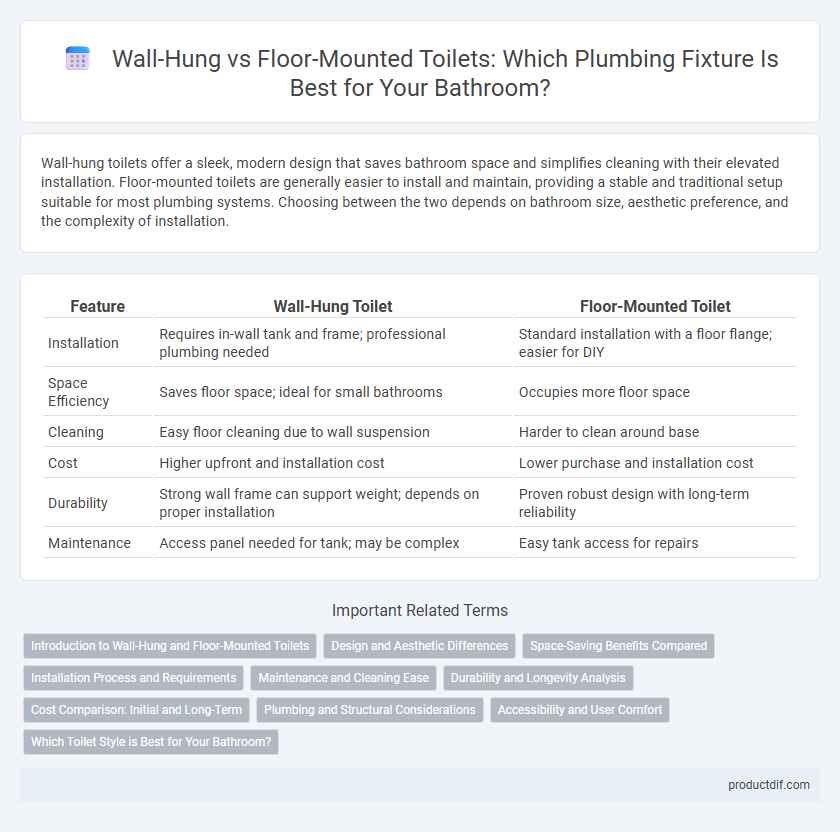Wall-hung toilets offer a sleek, modern design that saves bathroom space and simplifies cleaning with their elevated installation. Floor-mounted toilets are generally easier to install and maintain, providing a stable and traditional setup suitable for most plumbing systems. Choosing between the two depends on bathroom size, aesthetic preference, and the complexity of installation.
Table of Comparison
| Feature | Wall-Hung Toilet | Floor-Mounted Toilet |
|---|---|---|
| Installation | Requires in-wall tank and frame; professional plumbing needed | Standard installation with a floor flange; easier for DIY |
| Space Efficiency | Saves floor space; ideal for small bathrooms | Occupies more floor space |
| Cleaning | Easy floor cleaning due to wall suspension | Harder to clean around base |
| Cost | Higher upfront and installation cost | Lower purchase and installation cost |
| Durability | Strong wall frame can support weight; depends on proper installation | Proven robust design with long-term reliability |
| Maintenance | Access panel needed for tank; may be complex | Easy tank access for repairs |
Introduction to Wall-Hung and Floor-Mounted Toilets
Wall-hung toilets feature a concealed tank and mounting system hidden within the wall, offering a sleek and modern design that saves floor space and facilitates easier cleaning. Floor-mounted toilets, the traditional style, have the tank and bowl supported by the floor, providing robust stability and typically easier installation. Both types vary in cost, maintenance, and bathroom aesthetics, influencing choice based on space optimization and plumbing preferences.
Design and Aesthetic Differences
Wall-hung toilets feature a sleek, minimalist design with the tank concealed within the wall, creating a streamlined appearance that enhances modern bathroom aesthetics. Floor-mounted toilets offer a traditional look with the tank and base fully visible, adding a substantial presence and often fitting well in classic or rustic bathroom designs. The wall-hung option facilitates easier floor cleaning and contributes to a spacious feel, while floor-mounted models provide a familiar, sturdy look that can complement diverse interior styles.
Space-Saving Benefits Compared
Wall-hung toilets offer significant space-saving benefits compared to floor-mounted toilets by mounting directly to the wall, which frees up floor space and creates a more open appearance in small bathrooms. Their concealed tank systems and elevated bowls allow for easier cleaning underneath and maximize usable floor area, making them ideal for compact layouts. Floor-mounted toilets generally require more floor space and can visually dominate smaller rooms, reducing flexibility in bathroom design.
Installation Process and Requirements
Wall-hung toilets require a sturdy in-wall carrier frame and professional plumbing adjustments to support the fixture and conceal the tank, demanding more complex installation and precise measurements. Floor-mounted toilets are installed directly on the bathroom floor with simpler connections to the existing drain pipes, making them easier and quicker to install. Proper reinforcement and accessibility for maintenance must be considered for wall-hung models, while floor-mounted units prioritize secure bolting to the flange for stability.
Maintenance and Cleaning Ease
Wall-hung toilets offer easier cleaning and maintenance due to their elevated design, which provides unobstructed floor space underneath, allowing quick access for mopping and vacuuming. Floor-mounted toilets often accumulate dirt and grime around the base, requiring more effort and time for thorough cleaning. Wall-hung units feature concealed plumbing, reducing exposure to dust and simplifying repairs compared to the visibly connected pipes of floor-mounted models.
Durability and Longevity Analysis
Wall-hung toilets feature concealed tanks and sturdy wall brackets designed to support significant weight, offering enhanced durability when properly installed with high-quality materials. Floor-mounted toilets rely on direct floor anchoring, which can be more susceptible to shifting or gasket wear over time, potentially affecting longevity. Material composition, installation quality, and regular maintenance critically influence the lifespan of both fixtures, with ceramic components and corrosion-resistant hardware promoting extended use.
Cost Comparison: Initial and Long-Term
Wall-hung toilets generally have higher initial costs due to the need for reinforced wall frames and concealed plumbing installation, whereas floor-mounted toilets are more affordable and easier to install. Long-term expenses for wall-hung models can be lower, as their design facilitates easier cleaning and maintenance, reducing wear and tear on flooring and fixtures. Floor-mounted toilets may incur higher maintenance costs over time due to potential floor damage and more complicated access to plumbing components.
Plumbing and Structural Considerations
Wall-hung toilets require robust in-wall carrier systems to support the bowl's weight and conceal plumbing, demanding precise installation within load-bearing walls. Floor-mounted toilets connect directly to the floor flange and simpler plumbing setups, offering easier maintenance and installation flexibility. Structural reinforcements are essential for wall-hung models to prevent frame damage, while floor-mounted toilets distribute weight evenly on the floor.
Accessibility and User Comfort
Wall-hung toilets offer enhanced accessibility by providing adjustable seat heights and easier wheelchair maneuverability due to their open space beneath. Floor-mounted toilets typically require more floor space and may present challenges for users with limited mobility because of fixed height and bulkier design. User comfort improves with wall-hung models as they allow customized installation height, reducing strain during use.
Which Toilet Style is Best for Your Bathroom?
Wall-hung toilets offer a modern design with space-saving advantages, making them ideal for small bathrooms or a sleek aesthetic, while floor-mounted toilets provide easier installation and maintenance with a more traditional look. Consider bathroom size, plumbing configuration, and maintenance preferences when choosing between the two styles. Wall-hung models require a sturdy in-wall frame and typically higher installation costs, whereas floor-mounted toilets are more universally compatible and budget-friendly.
Wall-hung toilet vs Floor-mounted toilet Infographic

 productdif.com
productdif.com